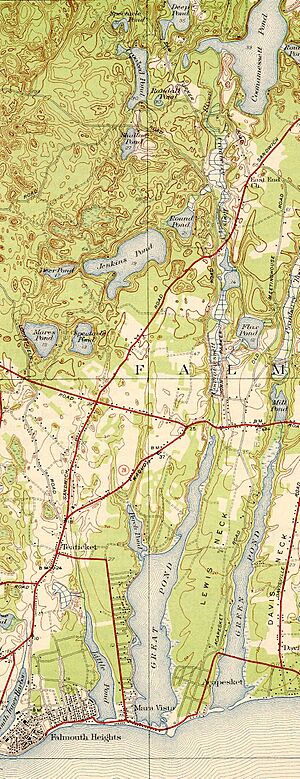Coonamesset River facts for kids
The Coonamessett River is a short river, about 3.1 miles (5 km) long, located in Falmouth, Massachusetts, on Cape Cod. It starts in Coonamessett Pond and flows south into Great Pond, which is an estuary (where fresh river water mixes with salty ocean water). Finally, it empties into the Vineyard Sound. The river is quite shallow and flows over old sand and gravel left behind by glaciers. It's a very important place for a major New England "herring run," which means many herring fish swim up the river to lay their eggs. Along its banks, you'll find red maple swamps, especially near where it starts and where it meets the ocean. Further down, much of the river is surrounded by large cranberry farms.
Contents
River History
Long ago, the Coonamessett River was likely surrounded by red maple or white cedar swamps. The Wampanoag people used to fish for herring here. When European settlers arrived around 1660, they first called the river the Five Mile River.
Around 1700, Philip Dexter built Falmouth's first grist mill (a mill for grinding grain) near the river's mouth. By 1795, there were three mills along the river. These mills used the river's water power, but they also made it harder for fish to swim upstream. This led to fewer fish, especially herring.
The Herring War
The decline in fish caused a "herring war" in 1798. This wasn't a real war with soldiers, but a big disagreement! A new town rule was made, giving an elected group the power to remove anything blocking the river. This was to allow fish to pass freely from April 1 to June 10 each year. The arguments became very heated. In 1805, a group against the herring rules even put herring into a cannon on the Village Green. The cannon exploded, showing how serious the conflict had become.
In 1865, another rule was passed to help the fish. It said that herring in the town's rivers should be allowed to swim freely without being bothered. Specifically for the Coonamessett River, fish were allowed to pass unbothered from 10 PM to 5 AM every day.
Cranberry Bogs and the River
In 1891, the Swift brothers changed parts of the river's wetlands into cranberry bogs. This meant they straightened, built dikes (walls to hold back water), dammed, and channeled the river. Some parts of the river became like a simple ditch. However, much of the river today still winds through the wide-open cranberry farms. By 1895, cranberry farming grew a lot, producing 15,000 barrels of cranberries.
In 1912, a biologist named David Belding wrote a report about the fish in Massachusetts. He noted that below Coonamessett Pond, the river was a narrow channel. He also mentioned that the stream flowed through 150 acres (0.6 km²) of cranberry bogs, crossing nine embankments before reaching a series of five ponds.
Belding reported that in 1906, alewives (a type of herring) were plentiful in the Coonamessett River. A 300-yard (274 m) ditch was dug to help the fish reach Coonamessett Pond, which was an excellent place for them to lay eggs. He believed the river was naturally good for these fish. He also pointed out that the cranberry industry and the fish needed to find a way to coexist, suggesting that bog owners should make sure fish could pass through.
Protecting the River Today
In 1971, the town of Falmouth bought over 100 acres (0.4 km²) of land, including cranberry bogs and parts of the Coonamessett River. The town had two main goals: to protect the environment and to continue growing cranberries. At the time, farming was quickly disappearing in Falmouth, so preserving cranberry cultivation was very important.
Since then, cranberry farming has continued, but people have also become more aware of environmental protection. For many years, the Coonamessett River had a healthy herring run even with the cranberry farms. However, in recent years, the number of herring has dropped a lot. This decline is happening across New England and is thought to be caused by factors in the ocean, not just in the rivers. For example, in 2004, only 640 fish were counted, and only about 2,000 herring returned to lay eggs.
River Challenges
People in Falmouth are now very concerned about the herring run and the disappearance of sea-run trout. They agree that the river needs better protection and improvements for fish. Some of the main problems include:
- Overfishing: Too many fish being caught, which reduces the number that can return to the river.
- Dutchman's Ditch: This ditch is at the start of the river and is the only way for herring to reach Coonamessett Pond to lay eggs. However, it often dries up in the summer when the main herring run happens.
- Water Temperature: The river's temperature has increased because of a reservoir used for farming and a lack of shade along much of the river. Trout need cooler water to survive.
- Spawning Grounds: Sand released from behind dams has flooded parts of the riverbed, destroying places where fish lay their eggs.
While some debates about the river's depth or nitrate levels have been found to be less of a problem, many of the major issues still need to be fixed. This is partly because not everyone agrees on how much cranberry farming should continue in the future.


